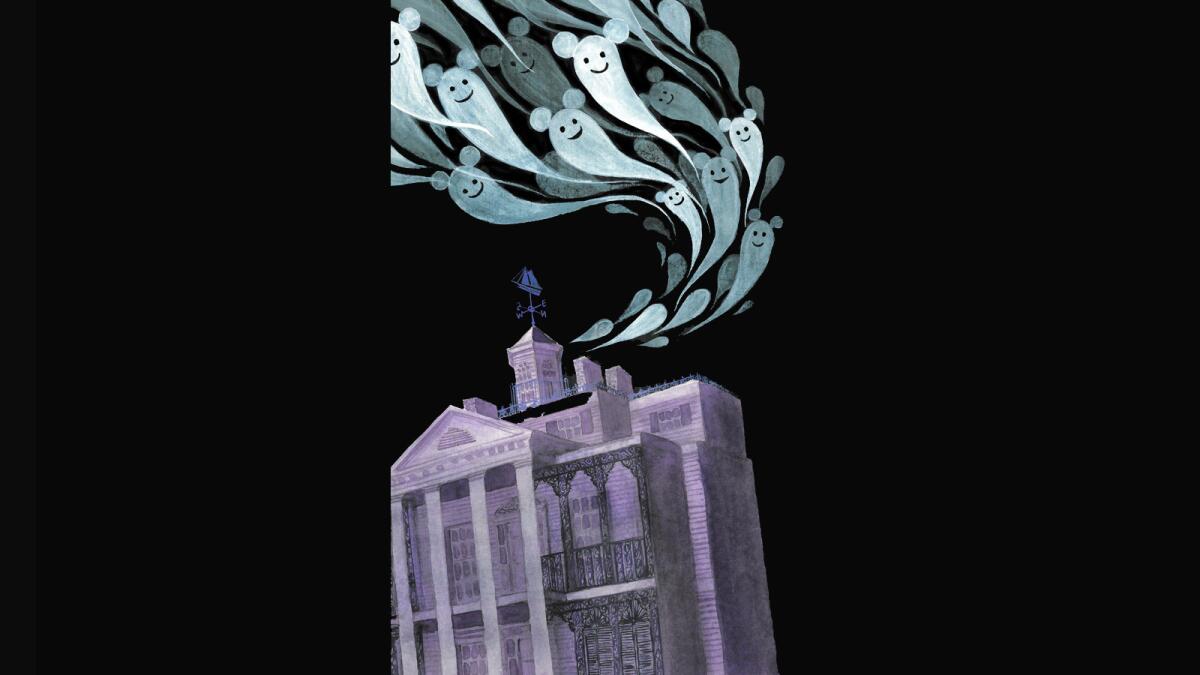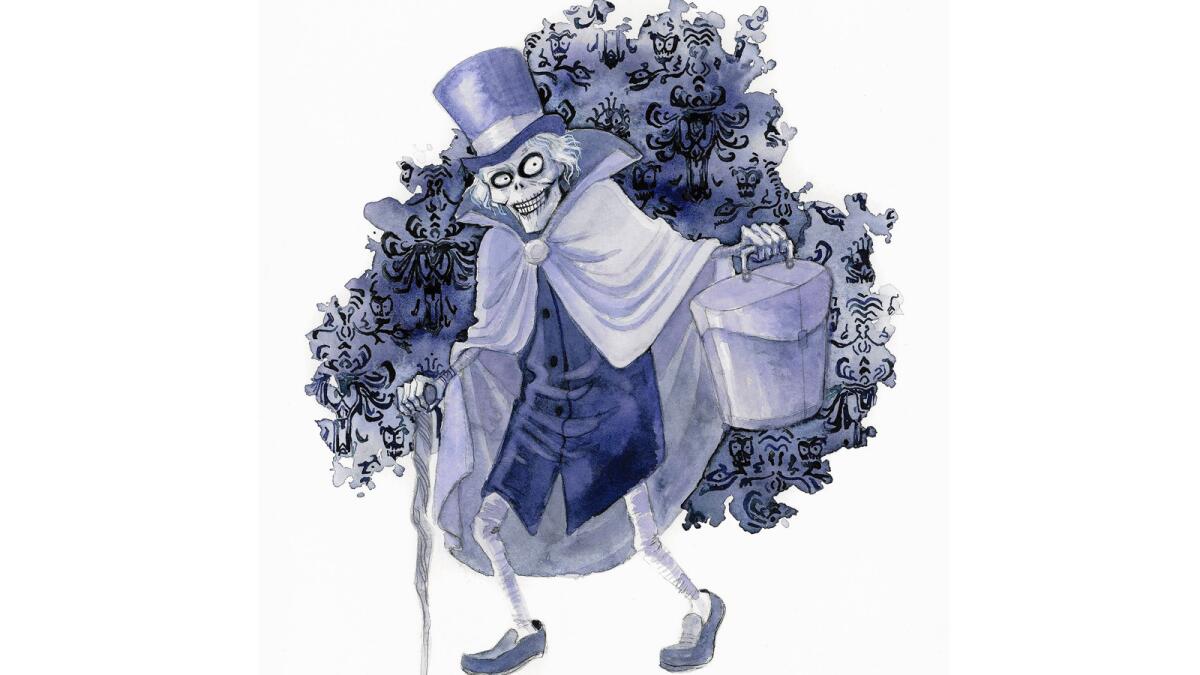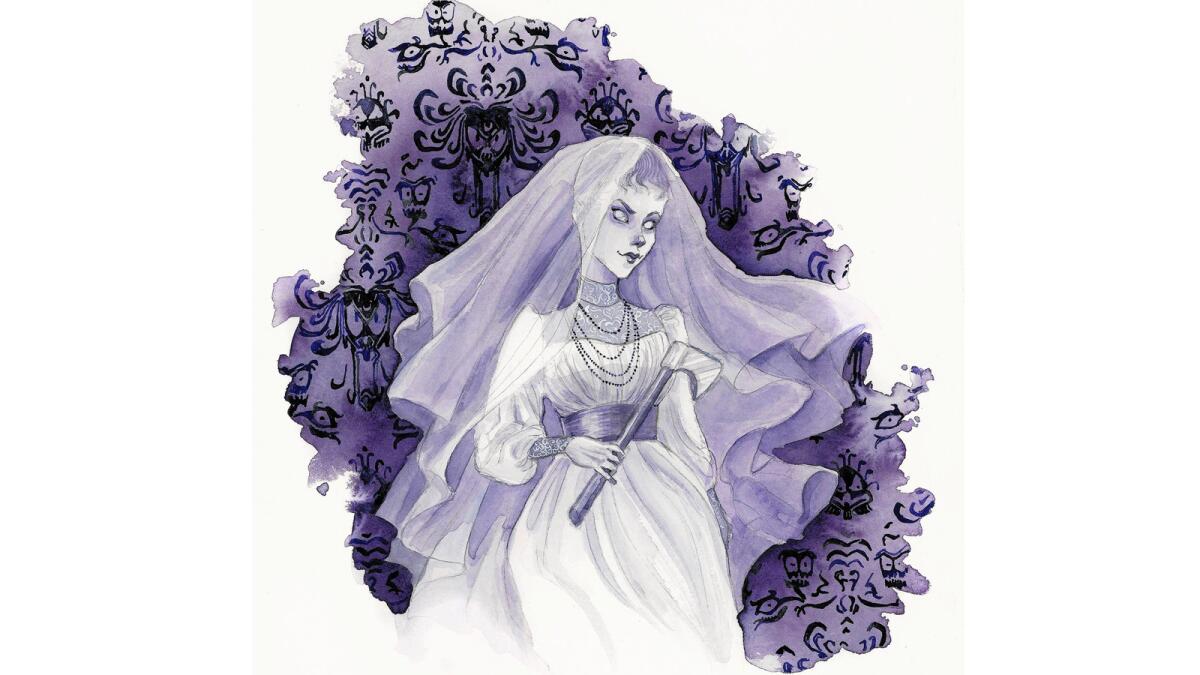Digging up the ghosts of Disneyland’s Haunted Mansion ride

Artist rendering of the front of the Disneyland Haunted Mansion ride.
- Share via
Long before there were hitchhiking ghosts or merry ghouls frolicking in a ballroom, there was the tale of a sea captain — a sea captain who murdered his wife and buried her in a brick wall.
This sea captain was once destined for Disneyland’s Haunted Mansion, but this gruesome tale of a ship commander has largely been forgotten.
To delve into the Haunted Mansion’s past is to discover perhaps the greatest whodunit in Disneyland history.
See the most-read stories in Entertainment this hour >>
This year, the Haunted Mansion’s plot thickened. The Hatbox Ghost, thought long lost to history, returned.

Artist’s rendering of the hatbox ghost from Disneyland’s Haunted Mansion.
Since it opened in 1969, the hows and whys of the Mansion’s story are a thing of myth and fan speculation. Did the house once belong to a bride in the attic? What about those singing ghosts in the graveyard? And just who is this Hatbox Ghost?
He’s still wearing an ominous cape, and sometimes he is seen with a head, sometimes without (thus the handy carrying case). He was there when the ride opened, then mysteriously disappeared just days later, only to return this year for the park’s 60th anniversary. In the decades in between, he became a cult figure, one that would show up on Disney merchandise despite not having a home to call his own.
“The Hatbox Ghost was one of those things that really nobody got to see. He was a forbidden fruit,” says Daniel Joseph, a principal special-effects designer at Walt Disney Imagineering, the company’s highly secretive arm devoted to theme park experiences.
Unlike Peter Pan, Alice in Wonderland or even today’s Pirates of the Caribbean, the Haunted Mansion is the rare Disney ride without a strong plot. Stories that might explain a visitor’s journey through the stretching chamber, the hallway of shape-shifting portraits or the graveyard in full swing are as fleeting as those ghosts who promise to follow you home but don’t. It’s a melange of scenes filled with oddities, be it a coffin in a conservatory or a disembodied head in a crystal ball.
But if Disneyland is a temple to one’s imagination, then the Haunted Mansion is the one ride that truly requires visitors to use it. To string the different acts of the Mansion together is entirely up to the guest. Often, no two theories will be the same. Sites online, such as Doombuggies, analyze nearly every square inch of the Mansion, and some knowledgeable fans (they go by the name the Disney History Institute) even created a seven-minute video just on the questions surrounding the Hatbox Ghost, a clip that today has more than 360,000 views on YouTube.
Not even insiders are privy to his tales of woe. As his head disappears and then reappears inside of a hatbox, all along it carries an exaggerated grin that foreshadows devilish desires.
“That’s spooky,” says Tony Baxter, who in 2013 left his senior position at Imagineering for a creative advisory role. “I want to know what the story is here.”
What the story is has a tendency to change based on who’s doing the telling.
“It’s always been a mystery to me,” says Rolly Crump, one of the first Disney Imagineers to work on the Mansion, when asked about the Hatbox Ghost.
Today the Mansion is perhaps best known for its whimsy — the floating musical instruments, the painting that stretches to reveal a man in his underpants. It’s the haunted house at its most humorous, where singing busts serenade rather than spook.
But is it possible to get to the bottom of the Hatbox Ghost and, in turn, the Mansion itself?
To try to unravel the story of the Haunted Mansion is to discover a rather macabre past. There are nods to it today.
Just look up at the Mansion’s decorative rooftop. Inexplicably, there’s a weather vane in the shape of a sailboat. Could this signal that this is the home of a sea captain?
And pay close attention in the attic to unfurl the tale of a “black widow” bride, who appears as a gauzy silhouette. Just beyond the bride on a balcony is that poor fellow who keeps losing his head.
Wealth of theories
I’ve politely pestered numerous Disneyland staffers over the years to reveal whatever they may know about the ride’s story. All of their answers differ. Maybe the ride’s moving vehicle descends backward into a cemetery because you’ve been driven mad and jumped out a window. Maybe the only way out of a door-less stretching room is to commit suicide and become a ghost yourself.
Or maybe it’s none of the above.
“The story is meant to be self-interpreted as you go through,” Joseph says.
There’s plenty about the Haunted Mansion that isn’t a secret, but these tidbits often deal with the ride’s magic, much of it designed by Disney’s late master illusionist, Yale Gracey. The projections, for instance, that can bring a face to life or the Pepper’s Ghost effects that use angled glass and tricks of the light to make it look like ghostly hologram-like figures are having a ball.
Though the Mansion is the rare Disney ride without a built-in story, it’s not for lack of trying. There are, in fact, strong stories contained in the ride — perhaps no more so than in the attic — and today dribs and drabs about the ride’s beginnings have spilled from Disney coffers.
From the mid-1950s until Walt Disney’s death in 1966, three years before the Mansion opened, there was one consistent problem: “When [Walt] was alive, they never could come up with a story that he bought into,” former Imagineering chief Marty Sklar says.
Crump was paired with Gracey in the late ‘50s by Walt Disney. So, what kind of direction did the creator of the Mouse give Crump and Gracey?
“No direction whatsoever,” Crump says.
“I think that goes back to the way Walt worked in animation,” Crump says. “He’d put a couple of story guys together and he’d give them a subject, whether it was Peter Pan or Snow White, and let them design the ride and come up with whatever they could come up with. After they had something that made some sense, then Walt would sit down with them. That’s what he wanted Yale and I to do, and we ended up just being illusionists.”
But there were initial story threads behind some of those illusions.
The ride’s beginnings date to the early to mid-1950s, first gaining major traction when Walt Disney assigned the project that would ultimately reside in the New Orleans Square section of Disneyland to Ken Anderson, an animator turned Imagineer. Anderson, says Sklar, took the first known crack at a story.
Anderson’s treatments give the ride a much more disturbing core than its current incarnation. A Disney Editions book, “The Haunted Mansion: Imagineering a Disney Classic,” details Anderson’s initial drafts.
They all present a morbid twist for the family attraction. There was a sea captain — Capt. Bartholomew Gore, to cite one of his early names — who was actually a notorious pirate. His young wife, on discovering this news, was murdered — bricked in a wall in one version of the story, thrown down a well in another. Harrowing stuff, and it’s not exactly G-rated.
Using glass, lighting and a bathtub, Gracey and Crump created as close to an origin story as one can find for the Mansion.
“The story was [that] the person who lived in there had been an old sea captain,” Crump says. “He had killed his wife, bricked her up in the wall. Then he died at sea.
“The way Yale and I came up with it is that every now and again the ghost of the sea captain would come back and appear in his room. We did this illusion where he had the old slicker hat and coat, like he had been out in the ocean. We had him staged and reflected in the glass. He was standing in a shower. The water was coming down over the top of him and it was coming over the floor. It was a beautiful, beautiful illusion, Then we had her appear behind the brick wall, and she comes out screaming and attacks the sea captain. Then they both disappear.
“That,” continues Crump, “would have been one of the best illusions we could have ever shown.”
Except it only worked when the Mansion was designed to be a walk-through attraction. As the Mansion remained in the planning stages and work continued on and off throughout the ‘60s, technology advanced and allowed for guests to be whisked through the house on moving vehicles. The sea captain tale dreamed up by Gracey and Crump was too elaborate to be repeated every few seconds.
“You could look out the window and see the waves from the ocean. You could see bats flying. You could hear wolves howling. We built quite a little set,” Crump remembers.
While Gracey would be known for creating many of the Mansion’s illusions, Crump’s designs got increasingly weird, so much so that there were once plans to have a so-called Museum of the Weird in the Mansion.
“The Museum of the Weird, if Walt had lived, I think it would have been the pre-show to the Haunted Mansion rather than the story itself,” Sklar says.
Among some of Crump’s designs were a “Beauty and the Beast”-inspired melting candelabra man, man-eating plants, a Gypsy-inspired seance room, a grandfather coffin clock and an aquarium with ghost fish. Oh, there was also the sketch that would eventually become some of the Mansion’s wallpaper, in which creatures with elongated bat-like eyes scowl at visitors as they pass.
For all of his designs, Crump says, he and Gracey were simply following the tradition of prior Disney animators.
“When Yale and I first started, a lot of people in animation had worked on concepts for the Mansion way back in the early ‘50s,” Crump says. “Walt always wanted a Haunted Mansion in Disneyland. We went through all of that, but there was no continuity. It was all an idea here, an idea there. So we did the same thing.”
The black widow
Perhaps the only spot in the Mansion where there’s essentially one clearly defined through-line is in the attic, where since the mid-2000s a bride named Constance has resided. Nicknamed the black widow bride, Constance appears in a wedding gown, speaking her vows. Strewn about the attic are gifts and photos, all of them featuring a doomed groom who fell under Constance’s spell.

Artist’s rendering of the bride from Disneyland’s Haunted Mansion.
Constance is voiced by actress Kat Cressida, who herself is something of a Disney aficionado. She once worked at Disneyland as a tour guide on the Storybook Land Canal Boats and has devoured as much knowledge about Constance as she could possibly find.”She’s a black widow bride. She kills off her husbands and moves on to the next. She would keep trying for more wealth. That was the motive,” Cressida says.
Cressida recalls what she was told on one of her auditions. “All I was given ... was that it’s realistic, don’t go cartoony with the voice and to know that she’s lovely — she’s the kind of person who is irresistible to every man, and maybe she has a secret. That was all that I was given.”
If you look closely at various wedding pictures, you’ll see that the pearls around Constance’s neck get more extravagant with each groom. There had, of course, been brides in the attic before Constance. Longtime Disneyland fans will recall a bride with a beating heart. Was she the original wife of the sea captain who was offed? Or someone else entirely? Or maybe she died of a broken heart, awaiting her love to return?
No matter, as Constance gives the Mansion a central figure who could perhaps be a reason for all the mayhem.
“I love the fact that they created this empowering story of a bride who wasn’t a victim. I’m not thrilled she murdered a bunch of people, but it’s a funny story — sort of, in a twisted black humor sort of way,” Cressida says.
Immediately past Constance is one of the Mansion’s newest figures — or one of the oldest, depending on how you look at it. The Hatbox Ghost was in the ride on opening day — Baxter remembers seeing it himself — but was taken out in a matter of days. Or maybe weeks. The facts are hazy.
Regardless, very few Disneyland visitors ever saw the original Hatbox Ghost. “The number I keep hearing is about a week,” says Disney’s Joseph when asked how long the Hatbox Ghost was in the Mansion. “Some people say a few months. What I’ve heard a few times more than the rest is about a week.”
The story is that Gracey was not happy with the effect of his head disappearing and reappearing.
“He didn’t live up to the standards of his other gags that were in the Mansion,” Joseph says. “I don’t see it as a failure. I see it as he attempted something that was really difficult in 1969, and it didn’t work back then.”
More modern digital effects allowed the Hatbox Ghost to return. Until he appeared in the Haunted Mansion this year, the Hatbox Ghost became something of a myth. Some doubted he was ever in the Mansion at all.
“It was phenomenal because it was a character that you don’t see in the ride. He was more popular than the characters that you do see in the ride,” Baxter says. He adds that original Hatbox Ghost designs by famed Disney animator and Imagineer Marc Davis, the man responsible for many of the Mansion’s inhabitants and sight gags, were used heavily in pre-opening day Mansion promotional materials.
“The Hatbox Ghost was front and center in everything,” Baxter says. “It’s a tribute to Marc Davis’ visual storytelling. The pose told a story about something that was intriguing and beckoning of the viewer. You wanted to know what’s going on. If it was just a straightforward mannequin of a ghost, it’d be far less interesting than this guy hobbled over with a hatbox that has a head in it.”
There were stories created for the Hatbox Ghost. A promotional album released by Disneyland Records in 1969 connected him to the bride in the attic, and Joseph says the modern-day Imagineering team that brought him back to life once had a rather direct tale for his existence in the Mansion, but instead decided to go ambiguous.
Still, there are hatboxes thrown about the attic near the bride, which are meant to imply some connection between the two.
“It’s a little bit of a subtle thing,” Joseph says. “It could have been much more literal, and we came up with very direct and literal stories, but we didn’t want to go that way. It turned out better that way. Is he related to the bride? Is he her long-lost love? He’s kind of all of the above.”
It’s a vague conclusion to his story but a fitting one, as it was the Hatbox Ghost’s very absence that helped create the mythology surrounding the Mansion in the first place. Here was a ghost thrilling in design but so out of place that the ride did without him for decades.
How he fit in, or didn’t, was left entirely for fans to ponder. And that, Crump says, is the key to the Mansion’s success.
“It’s because things got out that were done or never done. That opened up people’s imaginations to think, ‘What the hell is this really all about?’ That’s the secret. That’s the reason mysteries are so good. Because of that, there’s kind of like a cult.
“It’s because people love mysteries, especially a mystery from Walt Disney.”
More to Read
The biggest entertainment stories
Get our big stories about Hollywood, film, television, music, arts, culture and more right in your inbox as soon as they publish.
You may occasionally receive promotional content from the Los Angeles Times.











